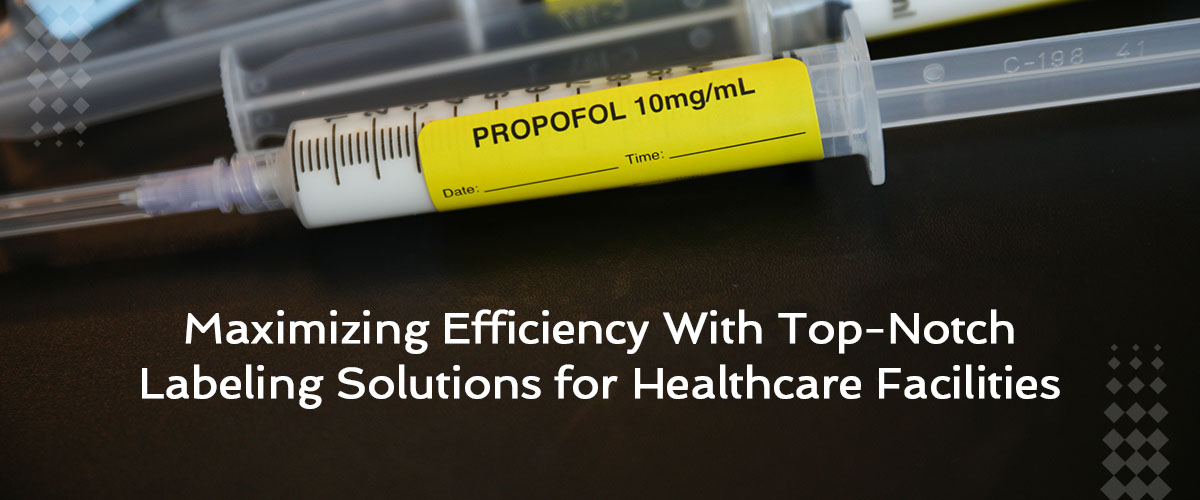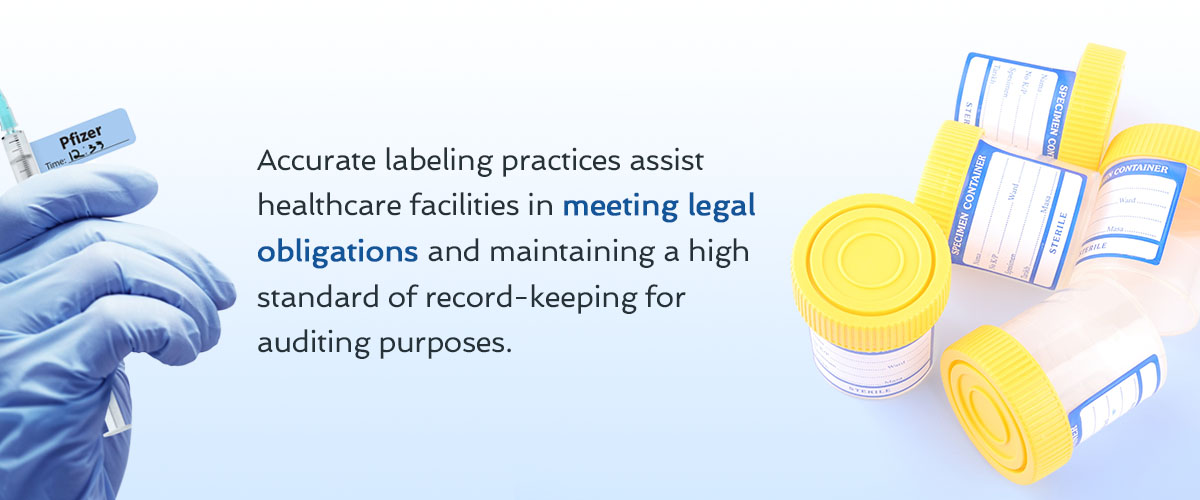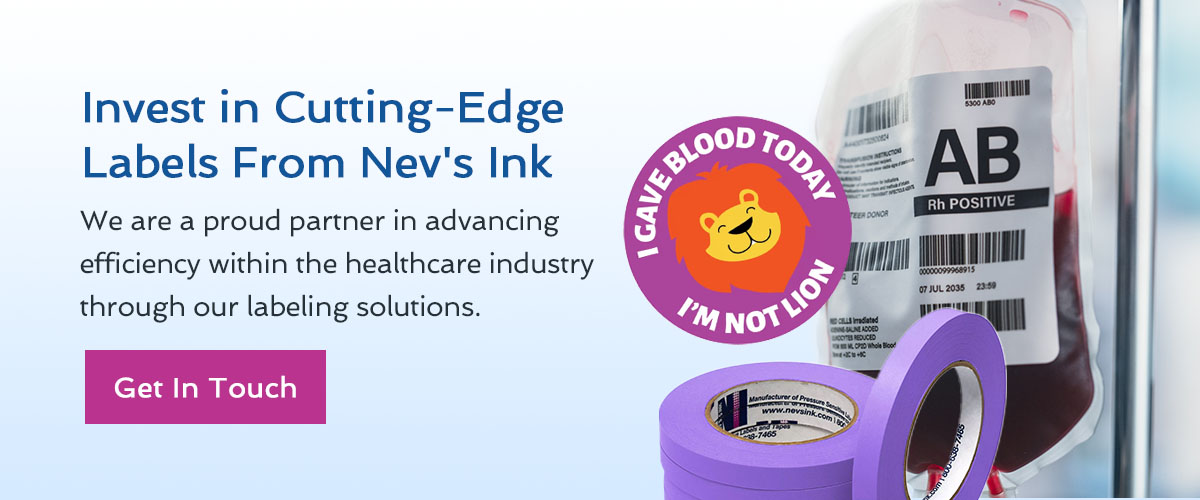
At the heart of every healthcare facility is a commitment to patient well-being. And that’s where labels can help. From precise patient identification to accurate medication management, labels are tiny pieces of paper or plastic with a massive impact.
So, how does labeling and printing in healthcare maximize your efficiency? Let’s explore the achievable possibilities.
Why Is Labeling in Healthcare Important?
Whether placed on test tubes, vials or blood bags, labels provide concise communication and contribute to a system that staff members can understand. Here are a few key reasons why labeling is crucial:
- Patient safety and identification: Accurate labeling is fundamental to patient safety. In these cases, labels come in the form of wristbands or medical records. All play a role in patient identification and reducing the risk of errors in treatment and care.
- Medication management and administration: Accurate medication labels are essential in healthcare. Accurate labels ensure that healthcare professionals administer the correct medications to the right patients at the right times, which can help minimize the potential for medication errors.
- Regulatory compliance and standards: There are stringent regulations and standards in healthcare. Proper labeling practices are necessary for compliance with these regulations. Through this, healthcare facilities adhere to industry standards and legal requirements.
- Streamline processes and reduce errors: Labels can help streamline various processes like patient check-ins, specimen tracking and inventory management. Well-designed labels contribute to your operation and patient care efficiency.
Whatever the application, labels must be precise and reliable. Luckily, the increase in technological advancements has paved the way for accurate and durable labels. Labeling technologies, such as barcoding and radio frequency identification (RFID), have significantly contributed to the efficiency of healthcare operations.
This advanced hospital labeling innovation enhances accuracy while introducing real-time tracking capabilities to optimize patient care and workflow processes. As such, labeling in healthcare is more than a procedural step.
Impact on Patient Check-In and Management
Labels are vital in optimizing the entire patient journey. Here are the aspects of their impact:
- Efficient patient identification: Labels are crucial in ensuring accurate and efficient patient identification during the check-in process. They can minimize the risk of errors and enhance the patient experience.
- Streamlined check-in processes: Well-designed labels — especially those incorporating technologies like barcoding or RFID — contribute to streamlined check-in processes. Such labels can reduce waiting times, improve efficiency and allow for a smoother patient flow through registration.
- Enhanced patient safety: Accurate labels can help healthcare providers match patients with their medical records, medications and treatment plans. This can reduce the likelihood of errors during check-in and subsequent management stages.
- Personalized patient care: Labels with patient-specific information help healthcare professionals deliver more personalized care. They can tailor treatment plans and medications based on individual patients’ needs and history.
- Optimized workflow and resource allocation: Efficient labeling positively affects the facility’s workflow and resource allocation. It allows for better tracking of patients, resources and medical equipment.
- Accurate record-keeping: Labels are integral to maintaining accurate and organized patient records. This ensures healthcare providers access up-to-date information during the patient’s entire journey — from check-in to ongoing management.
- Improved communication between departments: Labels provide a common language across different departments within a healthcare facility. As such, labels facilitate communication between registration, nursing, pharmacy and other departments involved in patient management.

- Support for compliance and reporting: Accurate labeling practices assist healthcare facilities in meeting legal obligations and maintaining a high standard of record-keeping for auditing purposes.
Durable and Tailored Labeling Options
It’s clear that labels have a profound impact on a healthcare facility. However, it’s the quality of these labels that also plays a role. Labels must be durable and customizable.
Labels must withstand exposure to various elements, such as moisture, chemicals , and frequent handling. Strong labels that endure these rigors ensure that crucial information remains legible and intact. Additionally, labels are not a one-size-fits-all deal. Labels must be customizable to cater to the unique demands of different healthcare facilities and departments, from patient-specific information to medication details and inventory manage
Secure Labeling Practices for Patient Privacy
Although labels can communicate important information, in some aspects, this information must be kept private. Such is the case with patient information. Ensuring patient privacy is an ethical imperative and a legal mandate in healthcare.
As a result, healthcare facilities must implement secure labeling practices to protect patient identities. Here are a few practices to consider:
- Unique patient identifiers: Assign each patient a unique identifier, such as a patient number, barcode or RFID tag. This way, you can access their information without revealing it.
- Limited information on wristbands: Patient wristbands should contain only essential information , such as a unique identifier and relevant medical details. Avoid displaying sensitive information like full names or detailed medical histories.
- Tamper-evident features: Incorporate tamper-evident features into labels to detect any attempts at unauthorized access or tampering. These features provide visual cues, such as changes in color or patterns.
- Role-based access controls: Restrict access to patient information and labeling systems based on job responsibilities. This helps maintain confidentiality and prevents inadvertent breaches.
- Regular staff training: Although not label-specific, it’s vital to conduct regular training sessions for healthcare staff on privacy protocols and secure labeling practices. Staff must understand the risks and procedures to maintain confidentiality.
Adaptable Labeling Systems in a Changing Industry
The healthcare industry is in a perpetual state of evolution, from medical technological advancements to regulatory landscape shifts. Healthcare professionals must navigate this complex environment that demands continuous adaptation.
As regulations evolve, so should labeling systems. Adaptable labels accommodate the integration of new technologies to support healthcare facilities in adopting innovations for enhanced efficiency and accuracy. Healthcare workflows also constantly evolve, and adaptable labeling systems should flexibly align with changing processes. These changes are necessary to improve patient management and operational efficiency — and labels should be considered in these improvements.
The importance of adaptable labeling systems lies in their ability to serve as dynamic tools that align with the fluid nature of the healthcare landscape. They empower healthcare facilities with a future-ready approach to labeling practices.

Invest in Cutting-Edge Labels From Nev’s Ink
If you’re looking for durable and customizable labeling solutions, then Nev’s Ink is here to help. We are a proud partner in advancing efficiency within the healthcare industry through our labeling solutions.
Explore our healthcare labeling solutions — whether you work in a hospital, lab, blood bank or pharmacy, we have something for you. We are committed to providing top-notch labeling solutions to maximize your healthcare facility’s efficiency. Feel free to reach out to us online if you have any further questions.


